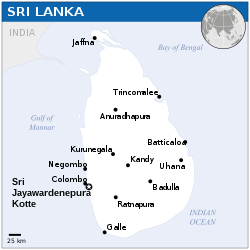Sri Lanka
| Democratic Socialist Republic of Sri Lanka |
|
|---|---|
 |
|
 |
|
| Capital | Sri Jayawardenepura Kotte (Administrative) Colombo (Commercial) 6°56′N 79°52′E |
| Largest city | Colombo |
| Official languages | |
| Recognised languages | English |
| Ethnic groups (2012[2]) | 74.9% Sinhalese 11.2% Sri Lankan Tamils 9.2% Sri Lankan Moors 4.2% Indian Tamils 0.5% other |
| Religion |
|
| Demonym | Sri Lankan |
| Government | Unitary semi-presidential constitutional republic |
| Maithripala Sirisena | |
| Ranil Wickremesinghe | |
| Karu Jayasuriya | |
| Priyasath Dep | |
| Legislature | Parliament |
| Independence from the United Kingdom | |
|
• Dominion
|
4 February 1948 |
|
• Republic
|
22 May 1972 |
| 7 September 1978 | |
| Area | |
|
• Total
|
65,610 km2 (25,330 sq mi) (120th) |
|
• Water (%)
|
4.4 |
| Population | |
|
• 2017 estimate
|
21,444,000[4] (58th) |
|
• 2012 census
|
20,277,597[5] (57th) |
|
• Density
|
327/km2 (846.9/sq mi) (43rd) |
| GDP (PPP) | 2018 estimate |
|
• Total
|
$298.310 billion[6] |
|
• Per capita
|
$13,847[6] |
| GDP (nominal) | 2018 estimate |
|
• Total
|
$86.607 billion[6] |
|
• Per capita
|
$4,020[6] |
| Gini (2010) | 36.4[7] medium |
| HDI (2016) | high · 73rd |
| Currency | Sri Lankan rupee (LKR) |
| Time zone | SLST (UTC+5:30) |
| Date format |
|
| Drives on the | left |
| Calling code | +94 |
| ISO 3166 code | LK |
| Internet TLD | |
|
Website
www |
|
Sri Lanka's documented history spans 3,000 years, with evidence of pre-historic human settlements dating back to at least 125,000 years.[11] It has a rich cultural heritage and the first known Buddhist writings of Sri Lanka, the Pāli Canon, date back to the Fourth Buddhist council in 29 BC.[12][13] Its geographic location and deep harbours made it of great strategic importance from the time of the ancient Silk Road through to the modern Maritime Silk Road.[14][15][16]
Sri Lanka was known from the beginning of British colonial rule as Ceylon (/sɪˈlɒn, seɪ-, siː-/). A nationalist political movement arose in the country in the early-20th century to obtain political independence, which was granted in 1948; the country became a republic and adopted its current name in 1972. Sri Lanka's recent history has been marred by a thirty-year civil war, which decisively ended when the Sri Lanka Armed Forces defeated the Liberation Tigers of Tamil Eelam (LTTE) in 2009.[17]
The current constitution stipulates the political system as a republic and a unitary state governed by a semi-presidential system. It has had a long history of international engagement, as a founding member of the South Asian Association for Regional Cooperation (SAARC), and a member of the United Nations, the Commonwealth of Nations, the G77, and the Non-Aligned Movement. Along with the Maldives, Sri Lanka is one of only two South Asian countries rated "high" on the Human Development Index (HDI), with its HDI rating and per capita income the highest among South Asian nations.[8] Sri Lankan constitution accords Buddhism the "foremost place", although it does not identify it as a state religion. Buddhism has given special privileges in Sri Lankan constitution.[18]
The island is home to many cultures, languages and ethnicities. The majority of the population is from the Sinhalese ethnicity, while a large minority of Tamils have also played an influential role in the island's history. Moors, Burghers, Malays, Chinese, and the aboriginal Vedda are also established groups on the island.
History
Prehistory
The pre-history of Sri Lanka goes back 125,000 years and possibly even as far back as 500,000 years.[30] The era spans the Palaeolithic, Mesolithic and early Iron Ages. Among the Paleolithic human settlements discovered in Sri Lanka, Pahiyangala (named after the Chinese traveller monk Faxian), which dates back to 37,000 BP,[31] Batadombalena (28,500 BP)[32] and Belilena (12,000 BP) are the most important. In these caves, archaeologists have found the remains of anatomically modern humans which they have named Balangoda Man, and other evidence[33] suggesting that they may have engaged in agriculture and kept domestic dogs for driving game.[34]One of the first written references to the island is found in the Indian epic Ramayana, which provides details of a kingdom named Lanka that was created by the divine sculptor Vishwakarma for Kubera, the Lord of Wealth.[35] It is said that Kubera was overthrown by his demon stepbrother Ravana, the powerful emperor who built a mythical flying machine named Dandu Monara.[36] The modern city of Wariyapola is described as Ravana's airport.[37]
Early inhabitants of Sri Lanka were probably ancestors of the Vedda people,[38] an indigenous people numbering approximately 2,500 living in modern-day Sri Lanka. The 19th-century Irish historian James Emerson Tennent theorized that Galle, a city in southern Sri Lanka, was the ancient seaport of Tarshish from which King Solomon is said to have drawn ivory, peacocks, and other valuables.



No comments:
Post a Comment